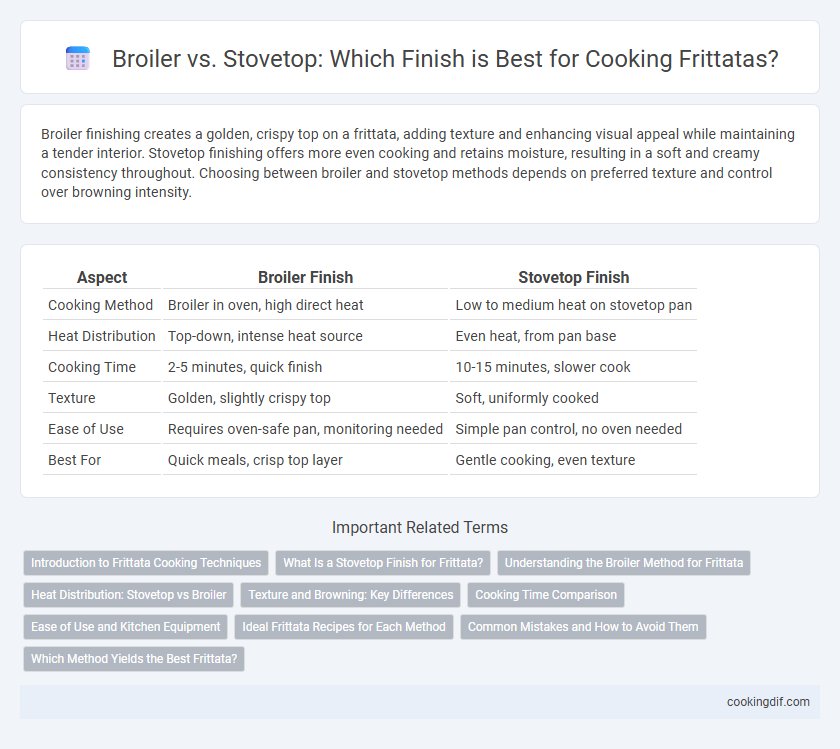Broiler finishing creates a golden, crispy top on a frittata, adding texture and enhancing visual appeal while maintaining a tender interior. Stovetop finishing offers more even cooking and retains moisture, resulting in a soft and creamy consistency throughout. Choosing between broiler and stovetop methods depends on preferred texture and control over browning intensity.
Table of Comparison
| Aspect | Broiler Finish | Stovetop Finish |
|---|---|---|
| Cooking Method | Broiler in oven, high direct heat | Low to medium heat on stovetop pan |
| Heat Distribution | Top-down, intense heat source | Even heat, from pan base |
| Cooking Time | 2-5 minutes, quick finish | 10-15 minutes, slower cook |
| Texture | Golden, slightly crispy top | Soft, uniformly cooked |
| Ease of Use | Requires oven-safe pan, monitoring needed | Simple pan control, no oven needed |
| Best For | Quick meals, crisp top layer | Gentle cooking, even texture |
Introduction to Frittata Cooking Techniques
Frittata cooking techniques influence texture and flavor, with broiler finishing delivering a crisp, golden top and a slightly firm edge, while stovetop finishing offers a softer, more uniformly cooked surface. Broiler finishing rapidly browns the eggs and toppings, enhancing visual appeal and adding a caramelized taste, whereas stovetop finishing requires gentle heat to set the frittata, maintaining tenderness throughout. Selecting between broiler and stovetop methods depends on desired doneness, ingredient moisture, and cooking time preferences for optimal frittata results.
What Is a Stovetop Finish for Frittata?
A stovetop finish for frittata involves cooking the egg mixture slowly over low to medium heat without transferring it to the oven, allowing the bottom to set gently while the top cooks through from residual heat. This method preserves a moist, tender texture and offers precise control to avoid overcooking or browning. Compared to broiler finishes that add a crisp, browned top quickly, stovetop finishing results in a uniformly soft and creamy frittata.
Understanding the Broiler Method for Frittata
The broiler method for finishing a frittata involves placing the pan under high direct heat to rapidly brown and set the top, creating a golden, slightly crisp surface. This technique is favored for its ability to cook the frittata evenly without overcooking the bottom, ensuring a tender, creamy interior. Using a cast-iron skillet or oven-safe pan under the broiler enhances heat distribution and results in a perfectly textured frittata finish.
Heat Distribution: Stovetop vs Broiler
Broiler cooking provides intense, direct heat from above, delivering a quick, caramelized finish on the frittata's surface with less risk of uneven cooking. Stovetop heat distributes more gently and uniformly across the pan's base, enabling a consistent cook through the eggs but may require careful temperature control to avoid burning or undercooking. Combining stovetop and broiler methods optimizes heat distribution, ensuring thorough cooking and a golden crust.
Texture and Browning: Key Differences
Broiler finishing creates a crisp, golden-brown crust on the frittata's surface, enhancing texture contrast with the creamy interior through direct intense heat. Stovetop finishing yields a softer, uniformly cooked exterior with minimal browning, maintaining a tender, custard-like consistency. The key difference lies in broiling's ability to caramelize toppings and edges, while stovetop cooking preserves even moisture without crispness.
Cooking Time Comparison
Broiler finishing for frittatas typically requires 3 to 5 minutes, providing a crisp, golden top quickly. Stovetop finishing takes longer, around 10 to 15 minutes over low heat, ensuring even cooking throughout without browning. Broiler methods offer speed, while stovetop finishes prioritize gentle heat for uniform texture.
Ease of Use and Kitchen Equipment
Broiler finishing for frittatas requires an oven-safe skillet and close monitoring to avoid overcooking, making it ideal for those comfortable with kitchen equipment and precise control. Stovetop finishing offers greater ease of use by cooking the frittata entirely on the burner, eliminating the need for oven use and reducing the risk of uneven cooking. Both methods yield flavorful results, but stovetop completion suits beginner cooks seeking simplicity and minimal equipment.
Ideal Frittata Recipes for Each Method
Broiler finish works best for frittatas with toppings like cheese, bacon, or vegetables that benefit from a crispy, golden-brown surface, ensuring even melting and enhanced texture. Stovetop finish suits softer, custard-like frittata recipes that require gentle, consistent heat to cook through without over-browning, ideal for delicate ingredients such as spinach or herbs. Choosing the broiler or stovetop method depends on desired texture and ingredient composition, making it essential to match the cooking technique to the specific frittata recipe for optimal flavor and presentation.
Common Mistakes and How to Avoid Them
Common mistakes in broiler finishing include uneven cooking and over-browning, often caused by placing the pan too close to the heat source or leaving it too long under intense heat. Stovetop finishing errors often involve undercooking the center or burning the edges due to inconsistent heat distribution and insufficient lid coverage. To avoid these issues, use a broiler-safe pan positioned at the right distance from the heating element and monitor closely, or finish on low heat with a tight-fitting lid to ensure even cooking throughout the frittata.
Which Method Yields the Best Frittata?
Broiler finishing creates a golden, slightly crisp top while maintaining a creamy interior, ideal for visually appealing frittatas. Stovetop finishing provides gentler, even cooking, resulting in a denser, custard-like texture without browning. For the best frittata, broiler finishing is preferred when a crisp, browned surface is desired, whereas stovetop suits a softer, uniformly cooked dish.
Broiler vs Stovetop Finish for Frittata Cooking Infographic

 cookingdif.com
cookingdif.com